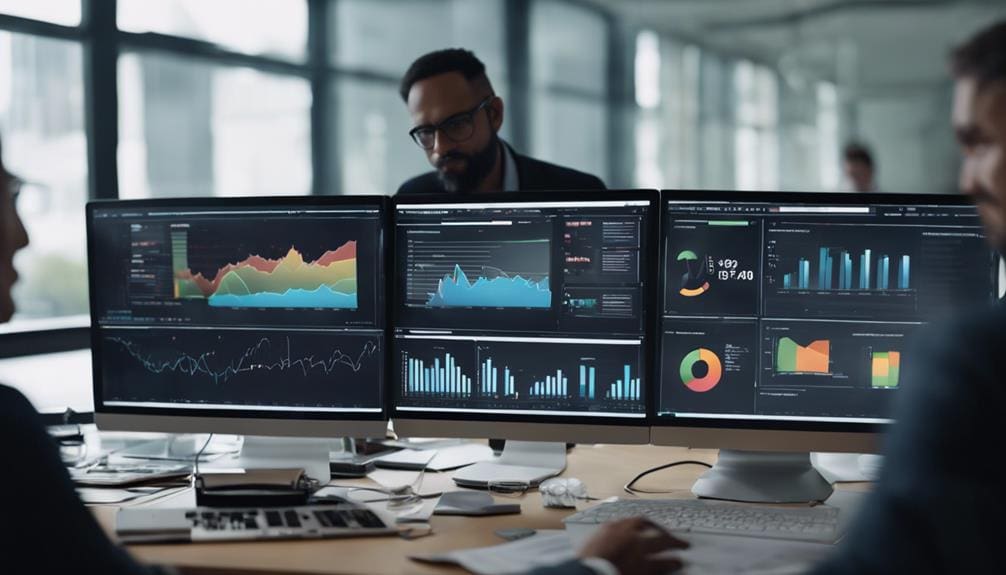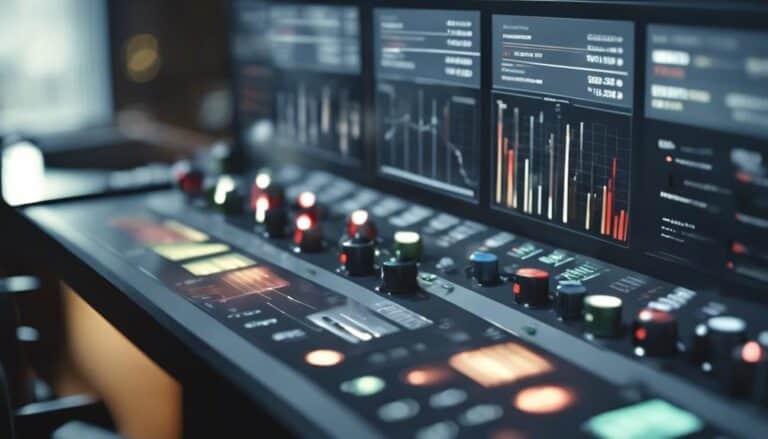While technology is a valuable component of project monitoring, the question remains: can tech alone guarantee project monitoring success?
The reliance on technological solutions is undeniable, yet the complexities of project management often demand more than just digital tools.
As you explore the interplay between technology and other essential project management elements, you may uncover a critical factor that could tip the scales in favor of project success.
Key Takeaways
- Tech enhances project monitoring efficiency but requires human judgment for success.
- Automated alerts and real-time tracking improve project control and decision-making.
- Integration of AI and data analytics maximizes monitoring accuracy and insights.
- Tech alone cannot ensure project success; human oversight and interpretation remain essential.
Importance of Project Monitoring Tools
Utilizing project monitoring tools empowers project managers with real-time visibility and data-driven insights to efficiently track progress, deadlines, and resource allocation. These management features are essential for maintaining control and ensuring an effective project.
Through project monitoring tools, communication within the team is streamlined, enabling quick updates, feedback, and collaboration.
Effective project monitoring requires tools that offer comprehensive reporting capabilities, allowing stakeholders to access project updates and status reports easily. Automated alerts and notifications play a crucial role in timely issue identification and resolution, preventing potential delays or setbacks.
Key Features for Effective Monitoring
To ensure efficient project monitoring, incorporating key features such as real-time progress tracking, automated alerts, customizable dashboards, seamless task management integration, and data analytics is imperative.
Real-time tracking allows you to stay updated on project developments instantly, ensuring timely decision-making.
Automated alerts serve as proactive indicators for any deviations from project timelines, enabling quick interventions to keep the project on track.
Customizable dashboards provide personalized views of project metrics and KPIs, allowing you to focus on the most relevant information.
Integration with task management tools streamlines monitoring by centralizing project data and progress updates in one location.
Data analytics offers valuable insights into performance evaluation and trend analysis, empowering you to make data-driven decisions for project management.
Integrating Tech for Monitoring Success
Integrating technology into project monitoring processes revolutionizes how data is analyzed and decisions are made in real time. By incorporating automation features and real-time monitoring tools, project management becomes more efficient and effective.
Here are four key ways tech integration enhances project monitoring success:
- Automation Features: Streamline monitoring processes, reducing manual intervention and potential errors.
- Real-Time Monitoring: Provides instant updates on project progress, allowing for quick decision-making and adjustments.
- Project Management Dashboards: Offer visibility into tasks, timelines, and resource allocation, aiding in tracking project milestones.
- Resource Optimization: Ensures efficient use of resources by identifying bottlenecks promptly and reallocating as needed.
Integrating technology not only improves project monitoring but also enhances transparency, accountability, and overall project success. By leveraging tech tools for project management, you can optimize performance and achieve better outcomes.
Challenges in Tech-Driven Monitoring
Navigating the realm of tech-driven project monitoring presents a myriad of challenges, including data overload and the delicate balance between automated alerts and human judgment. As a project manager, ensuring data accuracy is paramount for effective decision-making and project control. The challenge lies in sifting through vast amounts of data to extract meaningful insights without succumbing to analysis paralysis.
Moreover, integrating various data sources and systems to create a unified monitoring platform can be technically complex. It requires seamless coordination between team members and IT specialists to guarantee that all relevant information is captured and processed accurately. The risk of technology failures further complicates this process, as even minor glitches can undermine the integrity of project monitoring efforts.
To overcome these challenges, it's essential to establish robust quality control measures, regularly verify data accuracy, and have contingency plans in place for technology failures. By addressing these issues proactively, project managers can elevate the efficacy of tech-driven monitoring and enhance overall project management outcomes.
Maximizing Tech for Project Control
When maximizing technology for project control, leveraging data analytics capabilities becomes crucial for gaining valuable insights into project performance and progress.
Here are four key strategies to maximize tech for project control:
- Real-Time Monitoring: Utilize project management software to track progress and milestones instantly, ensuring timely interventions and adjustments.
- Automated Alerts: Implement automated alerts and notifications within tech tools to enhance project control and facilitate prompt decision-making processes.
- Data Analytics Insights: Harness the power of data analytics capabilities to evaluate project performance effectively, enabling informed decision-making for project success.
- AI Integration: Integrate artificial intelligence and machine learning technologies to enhance project monitoring accuracy and efficiency, ensuring that the project stays on track.
Frequently Asked Questions
How Do You Monitor the Success of a Project?
To monitor the success of a project, you track progress using key performance indicators. Analyze data for performance evaluation, mitigate risks and resolve issues. Engage stakeholders, communicate effectively, and collect feedback to ensure project success.
Who Is Responsible for Making Sure a Project Is Successful?
You are responsible for ensuring project success. Stakeholder involvement sets criteria; accountability measures track progress. Team collaboration drives deliverables. Leadership guides resources. Shared responsibility propels projects forward. Embrace each role to achieve success.
What Resources or Technologies Would You Use to Ensure the Project Is a Success?
To ensure project success, you would utilize team collaboration tools for seamless coordination, data analytics for informed decision-making, real-time tracking for monitoring progress, and risk assessment software for proactive mitigation. These resources enhance project management efficiency and effectiveness.
Can Project Management Be Taken Over by Ai?
Artificial intelligence can streamline project management through automation, boosting efficiency. Incorporating AI in project management tasks can enhance data analysis, risk prediction, and decision-making. While AI is valuable, human oversight remains essential for project success.
Conclusion
In conclusion, while technology is a powerful tool for project monitoring success, it can't guarantee success on its own. Just as a painter needs more than just a brush to create a masterpiece, project managers need to blend technology with soft skills and effective communication to achieve their goals.
By harnessing the full potential of technology alongside strong leadership, you can steer your projects towards success like a skilled captain navigating the seas.





